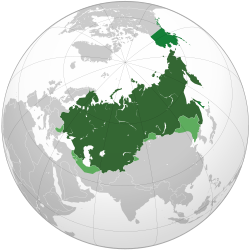During the period we are studying, Russia went through a massive deal of instability including five different rulers, two world wars, one civil war, intense class conflict, and general social upheaval. Because of this, I believe it is important to introduce you to some general knowledge about geography, societal makeup, and broad timelines of events.
Common terminology
- tsar – the russian word for king or emperor
- tsarina – the russian word for queen or empress
- a serf – someone who is indentured to serve a member of the higher class, much like a medieval English peasant
- tsarevich – the title given to the heir apparent to the throne, similar to ‘dauphin’ within the French monarchy
Physical Geography
The geography of russia is a very significant factor to examine when considering all the event that took place during the time period. It is the biggest country in the world, spanning more than 17 million km squared. It borders fourteen different countries and two oceans.
Why is this significant?? – the physical enormity of russia, especially considering the lack of technology of the given time period, means that it can take days, if not weeks, for news to be carried from one side of the country to the other, and it makes it much harder for any potential leaders, especially in the post-romanov conflict era when leaders held less legitimacy, to exert any authority over the people.
Social Geography
Although modern day russia is a single country, from the beginning of the time period in 1850 up until the abdication of 1917, it was largely identified as an empire and encompassed territories including modern day ukraine, some parts of scandinavia, and several asian territories.

Population sizes – during the time period the population of the russian empire grew drastically. In 1860 there was an estimates 75 million people, which had grown to approximately 136 million in 1900
Ethnic makeup – In addition to the physical size of russia, it is arguably the most ethnically diverse countries in the world, being comprised of more than 190 different ethnic groups. The amount of people in each group can vary with some groups, like the Tartars having millions of members, while others like the indigenous Sami people have less than 10,000 members.
All of this is significant when studying the time period because the vast differences in ethnic groups, cultures, nationalities, and even languages made russia a large and unruly area to control for any of the leaders.
Timeline of events
Now that the preliminary introduction to the make up of russia is concluded, I will lay out a brief overview of when specific events occurred.
1855 – Nicholas I dies and our first leader, Alexander II becomes the tsar
1877 – The Russo-Turkish War
1881 – Alexander II is assassinated and Alexander III becomes the tsar
1894 – Alexander III dies and Nicholas II becomes the tsar
1904 – The Russo-Japanese War
1905 – Nicholas II is almost overthrown and has to introduce some sort of reforms
1914 – Russia enters the first world war
1917 – February uprising results in the abdication of Nicholas
February to October – the Provisional Government rule
1917 – October uprising results in the rule of Lenin and the bolsheviks
1917 – November, the russian civil war begins
1918 – July, the former tsar and his family are assassinated
1922 – The civil war ends
1924 – Lenin dies
1924 to 27 – Major power struggle resulting in Stalin becoming the authoritarian leader
1939 to 1945 – The Second World War
1953 – Stalin’s totalitarianism ends